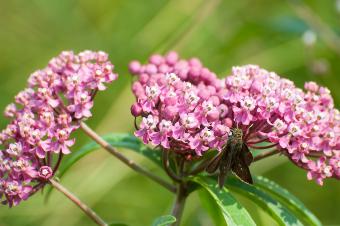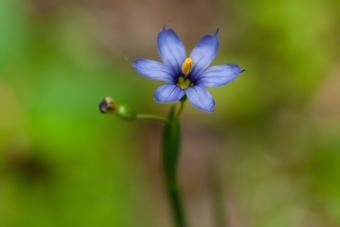
Rain gardens provide a beautiful way to catch extra rain runoff on your property. You need plants that'll tolerate lots of moisture during rainy areas. These are some plants that meet the brief and will look lovely in any rain garden.
Bee Balm

Bee balm (Monarda) is an adaptable perennial that can drink lots of water but can also survive just fine in drought-like conditions. This makes it a highly prized choice for unpredictable summer weather regions. Give it all the sun you can for a highly prolific flowering. Choose from a pink, red, or purple blossoming plant.
- Height: 30" to 36" tall
- Spread: 18" to 24" wide
- Zones: 3 to 9
- Blooms: July to September
Cardinal Flower

A perennial wetlands wildflower, the cardinal flower (Lobelia cardinalis) is considered an outstanding choice for a sunny pond or bog area. In less wet terrains, it fares best with partial afternoon shade. The brilliant red tubular flower makes a good naturalizing addition to any rain garden.
- Height: 24" to 48" tall
- Spread: 12" to 24" wide
- Zones: 3 to 9
- Blooms: July to September
New England Aster

The perennial New England aster (Symphyotrichum novae-angliae) features purple dome-mounding flowers. The blooms are larger than other aster species. This flower is typically planted in full sun but can survive in partial shade. Unlike some versatile rain garden plants, this aster species prefers moist soil.
- Height: 18" to 48" tall
- Spread: 24" to 48" wide
- Zones: 3 to 8
- Blooms: June to first frost
The New England aster can be aggressive if unchecked. It's susceptible to powdery mildew and doesn't tolerate hot dry weather.
Swamp Milkweed

Swamp milkweed (Asclepias incarnata) is one of the popular milkweed species that attracts Monarch butterflies. This perennial is also known as pink milkweed with large bloom clusters. As its name suggests, this variety needs moist soil. It can survive in partial shade but prefers full sun.
- Height: 24" to 60" tall
- Spread: 24" to 36" wide
- Zones: 3 to 8
- Blooms: June to October
Blue-Eyed Grass

Blue-eyed grass (Sisyrinchium angustifolium) may be called a grass and even look like a grass, but it is actually of the iris family. The blue, six-petal, star-shaped flowers feature a yellow eye and are sun lovers. This plant is self-seeding, but you'll want to divide it at least every three years.
- Height: 18" to 24" tall
- Spread: 6" to 12" wide
- Zones: 4 to 9
- Blooms: Spring
Marsh Marigold

A perennial succulent, marsh marigold (Caltha palustris) is aptly named since it loves wetland environments. The leaves are broad and kidney-shaped. The blooms are a misnomer since the yellow clusters resemble buttercups instead of marigolds.
- Height: 12" to 36" tall
- Spread: 12" to 24" wide
- Zones: 3 to 7
- Blooms: April to May
Marsh marigold's plant juices can blister or inflame when they come in contact with the skin. The leaves are toxic if ingested raw, but they can be eaten when boiled.
Sensitive Fern

Sensitive fern (Onoclea sensibilis) is a good heavy shade to partial shade naturalizing perennial plant. This native marsh and swamp plant is adaptable to nutrient-rich, well-drained rain gardens. The wetter the garden location, the taller the plant will grow.
- Height: 36" to 48" tall
- Spread: 36" to 48" wide
- Zones: 4 to 8
- Blooms: Non-flowering
Swamp Azalea

Swamp azalea (Rhododendron viscosum) provides beautiful white or pink blooms. This native swamp plant has a high tolerance for poorly drained soil and wet soils. It also has a high tolerance for land that occasionally floods, but the plant won't survive directly in water. The swamp azalea prefers the partial shade provided by dappled light from a canopy of trees.
- Height: 36" to 60" tall
- Spread: 36" to 60" wide
- Zones: 4 to 9
- Blooms: May to July
Choosing the Right Plants
When you select plants for your rain garden, first determine if you need full sun, partial shade, or full shade plants. Choosing plants of different heights will make your rain garden appear more natural and interesting.







